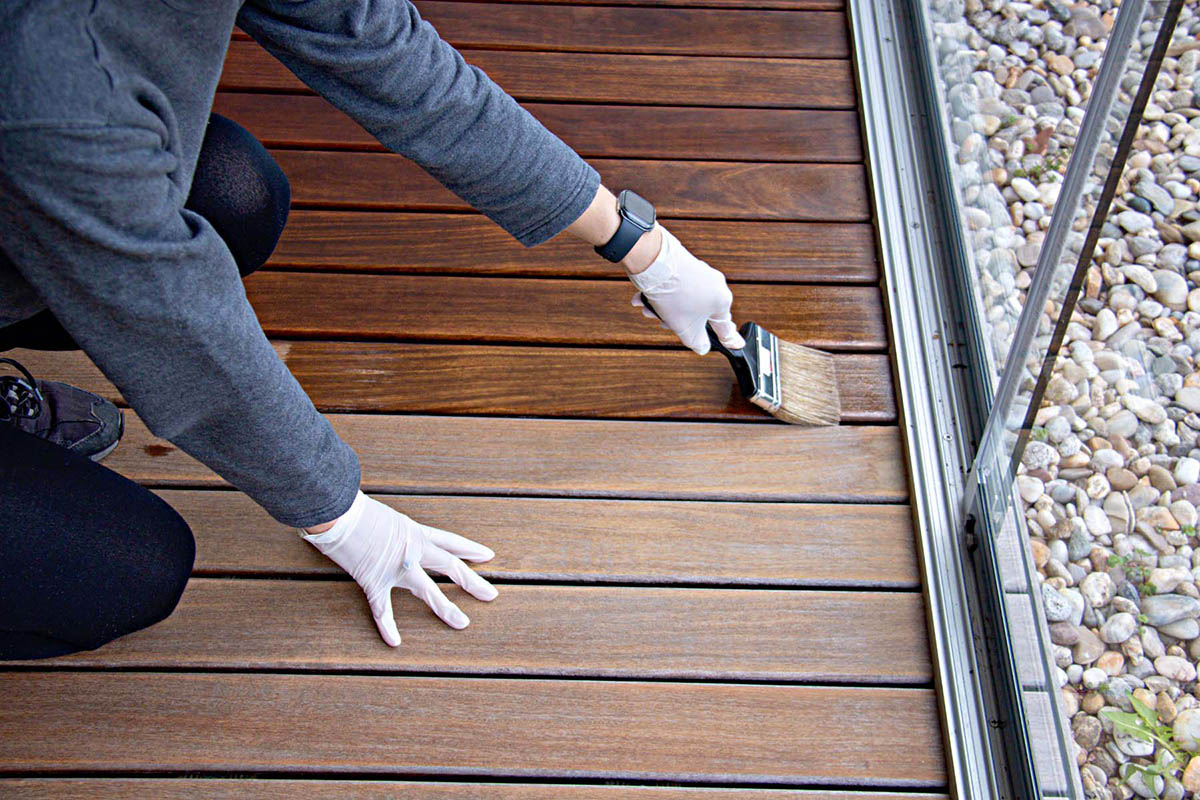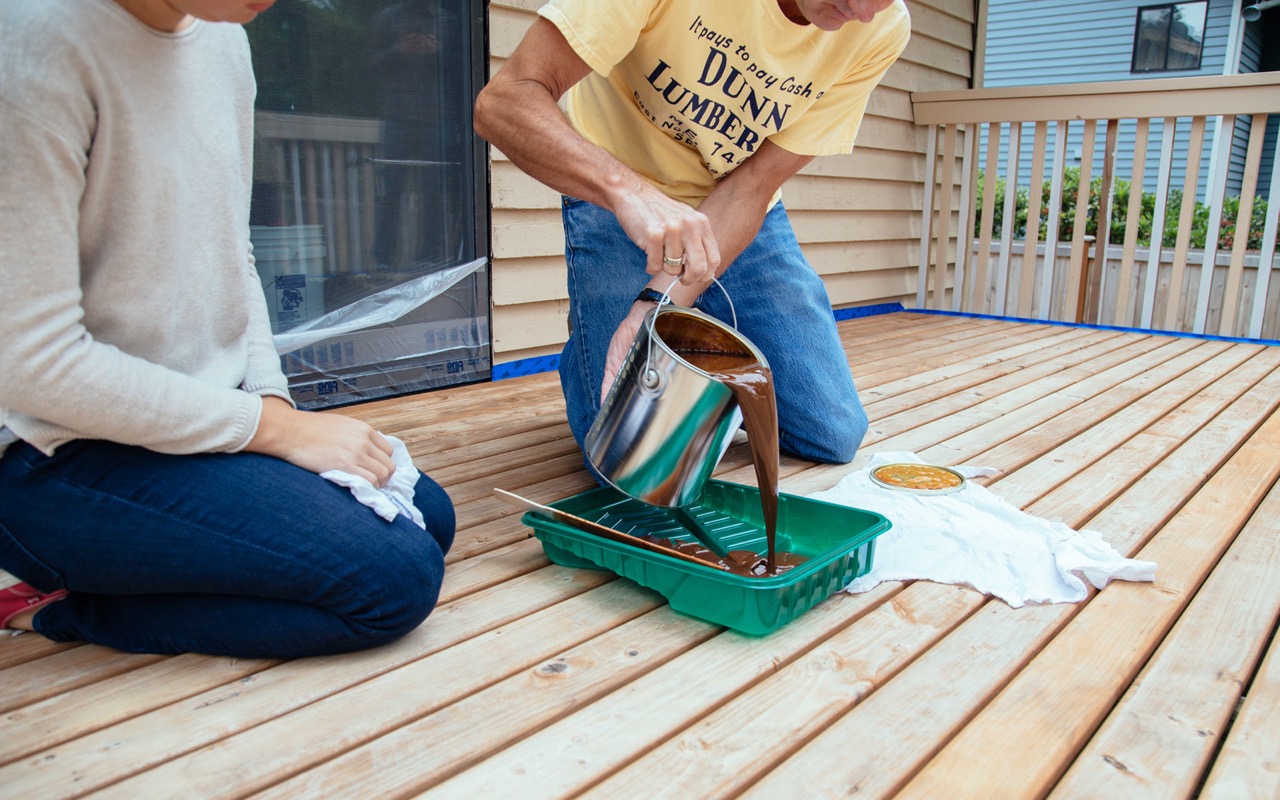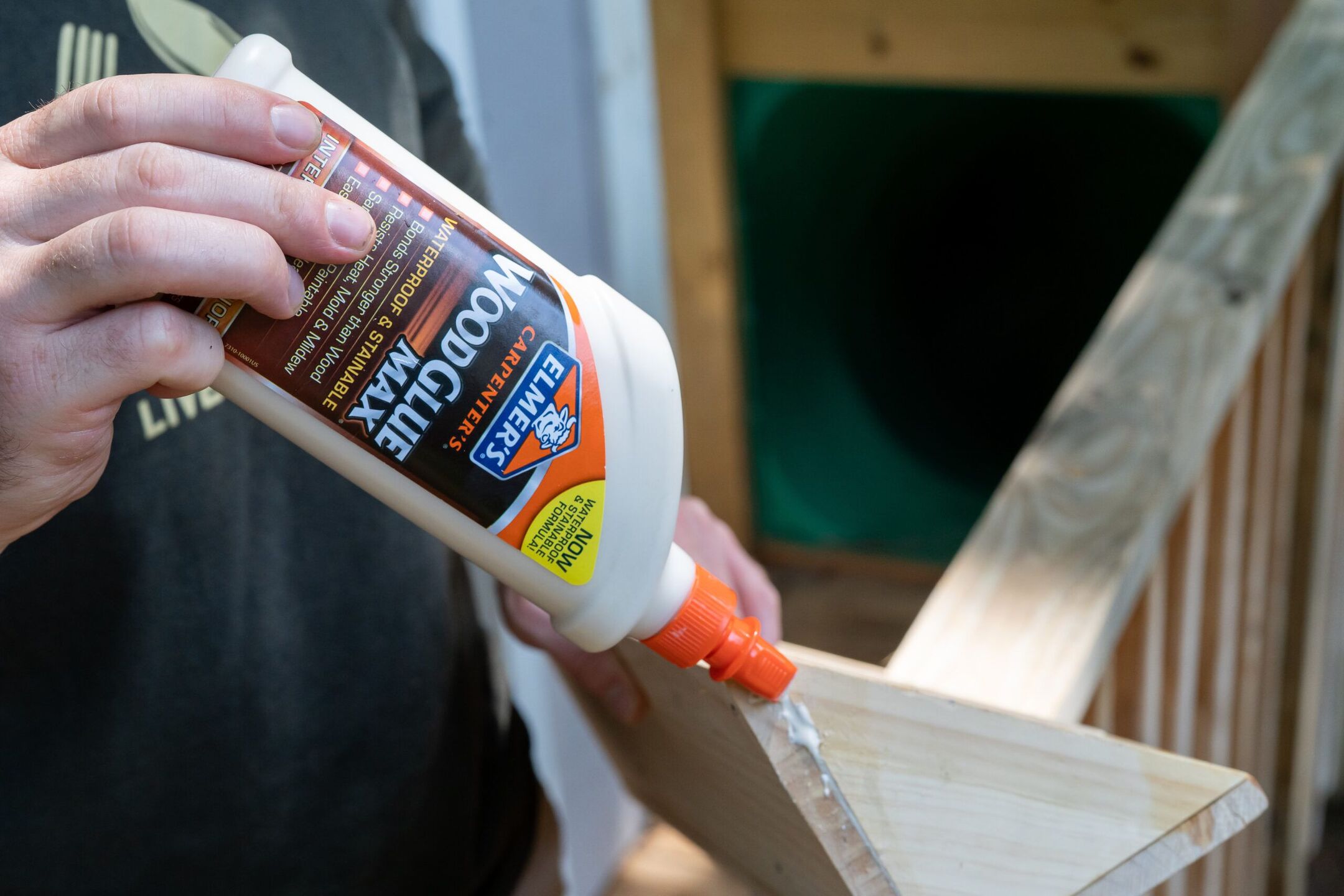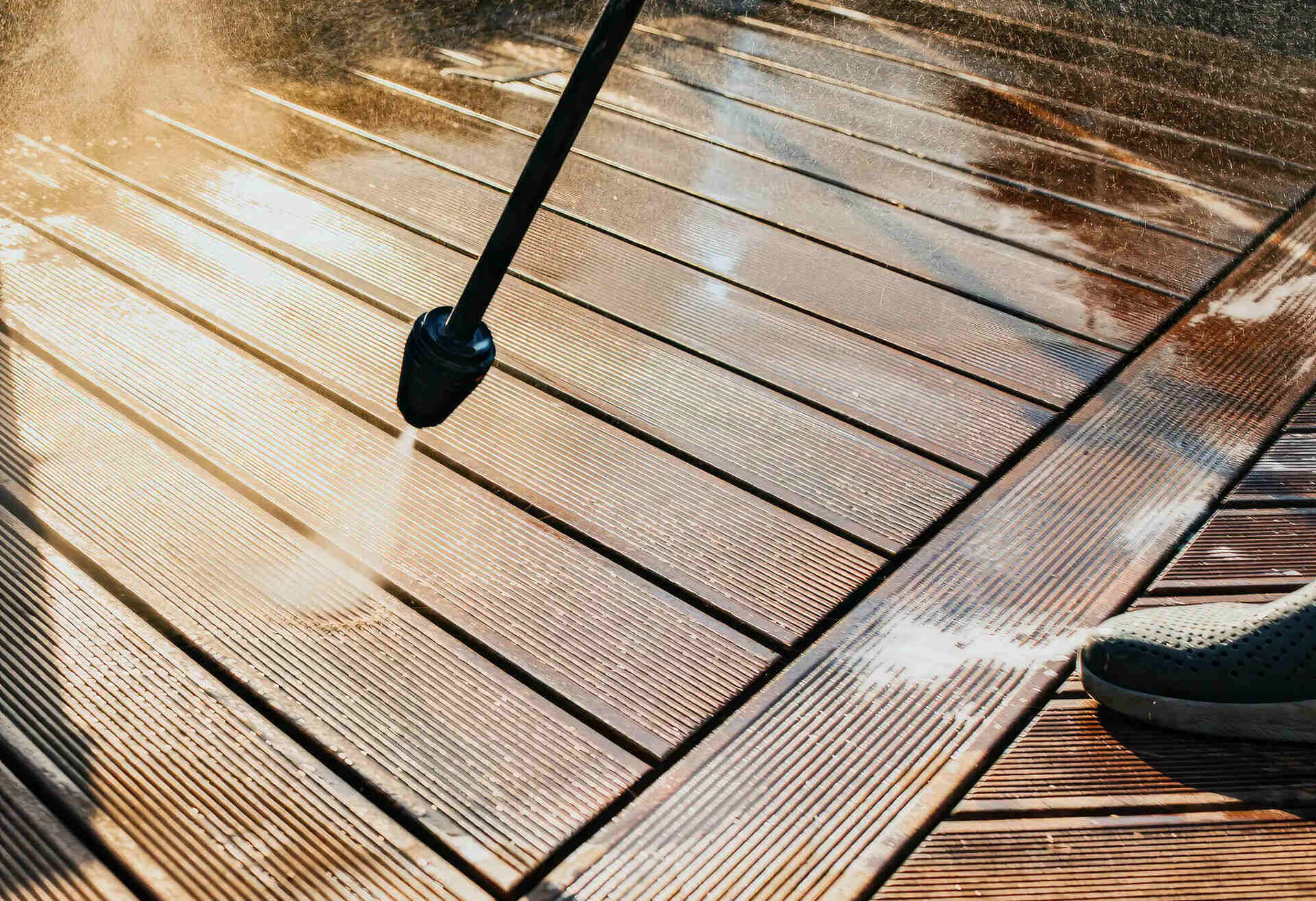Home>Furniture>Outdoor Furniture>What Is Best: Decking Oil Or Stain


Outdoor Furniture
What Is Best: Decking Oil Or Stain
Modified: March 7, 2024
Discover the best option for preserving your outdoor furniture with our guide on whether to use decking oil or stain. Protect and enhance the beauty of your outdoor living space.
(Many of the links in this article redirect to a specific reviewed product. Your purchase of these products through affiliate links helps to generate commission for Storables.com, at no extra cost. Learn more)
Introduction
Welcome to the world of outdoor furniture! When it comes to decking and preserving your outdoor furniture, there are a plethora of options available. One of the most common dilemmas faced by homeowners is choosing between decking oil and stain. Both options have their advantages and considerations, making the decision a bit confusing for some. In this article, we aim to help you understand the differences between decking oil and stain and provide insights into which option might be best for your outdoor furniture.
Decking oil and stain are designed to protect and enhance the natural beauty of your wooden outdoor furniture, such as decks, gazebos, and patio furniture. While they both offer protective qualities, they have distinct characteristics and application processes that set them apart.
So, let’s dive in and discover the differences between these two commonly used products and explore their pros and cons, as well as the factors to consider when choosing between them.
Key Takeaways:
- Decking oil enhances the natural beauty of wood and provides moisture protection, making it ideal for a warm, natural look with easy maintenance. However, it may require more frequent reapplication.
- Decking stain offers a wide range of colors and better surface protection, making it suitable for hiding imperfections and withstanding heavy use. However, it may obscure the wood’s natural characteristics and require more intensive application.
Read more: What Is The Best Product To Stain Decking
Definition of Decking Oil
Decking oil is a specially formulated product designed to nourish, protect, and enhance the appearance of wooden outdoor furniture. It is typically made from a blend of natural oils, such as linseed oil, tung oil, or a combination of various plant-based oils.
The primary purpose of decking oil is to penetrate deep into the wood and provide long-lasting moisture protection. It helps to prevent the wood from drying out, cracking, and becoming damaged due to exposure to harsh weather conditions, UV radiation, and general wear and tear.
Decking oil brings out the natural beauty of the wood by enhancing its color, grain, and texture. It provides a rich, warm look that can transform your outdoor furniture into a stunning focal point. Additionally, decking oil enhances the natural water resistance of wood, making it less susceptible to water damage and rot.
One key advantage of decking oil is that it is easy to apply and maintain. It usually comes in a clear or tinted form, allowing you to choose a finish that best suits your preferences. Some decking oils may also contain additives, such as mildew inhibitors or anti-slip properties.
It is important to note that decking oil provides a more natural finish compared to other coatings, allowing the wood to breathe and age gracefully over time. However, this also means that the level of protection offered by decking oil may not be as high as some other options.
Overall, decking oil is an excellent choice if you want to enhance the appearance of your outdoor furniture and provide long-lasting moisture protection without sacrificing the natural look and feel of the wood.
Definition of Decking Stain
Decking stain is a type of protective coating designed to add color, durability, and weather resistance to wooden outdoor furniture. Unlike decking oil, which penetrates the wood, decking stain sits on the surface of the wood, creating a visible layer.
Decking stains are available in a wide range of colors, allowing you to choose a shade that complements your outdoor space. From natural wood tones to vibrant hues, there is a decking stain to suit every style and preference.
The primary purpose of decking stain is to provide a barrier against the elements, protecting the wood from moisture, UV radiation, and general wear and tear. By forming a protective film on the surface of the wood, decking stain helps to prevent water damage, cracking, and fading.
In addition to protection, decking stain can significantly enhance the appearance of your outdoor furniture. It can bring out the natural grain and texture of the wood while adding depth and character to your decking or patio area.
One of the advantages of decking stain is that it offers a more durable and long-lasting protective layer compared to decking oil. The thickness of the coating creates a robust barrier that can withstand heavy foot traffic, furniture movement, and frequent exposure to the elements.
It is worth noting that decking stain tends to have a more opaque finish, obscuring some of the natural wood characteristics. While this can be a disadvantage if you prefer a transparent or natural look, it provides better coverage and can be helpful in hiding imperfections or blemishes on the wood surface.
Overall, decking stain is an excellent choice if you want to add vibrant color, durability, and protection to your outdoor furniture. It is particularly useful for high-traffic areas or where the wood has some visible flaws that you want to conceal.
Pros and Cons of Decking Oil
Decking oil offers several advantages and considerations that you should take into account when deciding whether it is the right choice for your outdoor furniture. Let’s explore the pros and cons of decking oil:
Pros:
- Natural look: Decking oil enhances the natural beauty of the wood, bringing out its color, grain, and texture. It provides a warm, natural finish that allows the wood to age gracefully.
- Moisture protection: Decking oil penetrates deep into the wood, nourishing and moisturizing it. This helps to prevent drying, cracking, and warping, particularly in areas with high humidity or exposure to moisture.
- Easy maintenance: Applying decking oil is relatively easy and can be done by most homeowners. It typically requires minimal preparation and can be reapplied as needed without the need for extensive sanding or stripping.
- Quick drying time: Decking oil usually dries relatively quickly, allowing you to use your outdoor furniture soon after application.
- Enhanced water resistance: Decking oil improves the natural water resistance of the wood, making it less prone to water damage and rot.
Read more: What Is The Best Way To Apply Decking Oil
Cons:
- Less durable: Comparatively, decking oil provides less surface protection compared to other coatings. It may require more frequent reapplication to maintain its effectiveness, especially in high-traffic areas or exposed to extreme weather conditions.
- Minimal color options: Decking oil typically comes in clear or tinted versions, offering limited color options. If you’re looking for vibrant or customized colors, decking stain might be a preferable choice.
- Lower coverage: Decking oil generally provides less coverage per unit compared to decking stain. This means you may need to use more product to achieve the desired result.
Considering these pros and cons will help you make an informed decision on whether decking oil is the right option for your outdoor furniture. It is essential to evaluate your specific requirements, priorities, and maintenance preferences before making your choice.
Pros and Cons of Decking Stain
Decking stain offers a unique set of advantages and considerations that should be taken into account when deciding whether it is the right choice for your outdoor furniture. Let’s explore the pros and cons of decking stain:
Pros:
- Color options: Decking stain comes in a wide range of colors, allowing you to customize and enhance the appearance of your outdoor furniture. From natural wood tones to vibrant hues, there is a decking stain to suit every style and preference.
- Enhanced protection: Decking stain forms a visible protective layer on the surface of the wood, offering a robust barrier against moisture, UV radiation, and general wear and tear. It provides better durability and protection compared to decking oil.
- Improved coverage: Decking stain offers better coverage per unit compared to decking oil. This means you may need to use less product to achieve the desired result, making it more cost-effective in the long run.
- Concealing imperfections: The opaque finish of decking stain can help in hiding minor imperfections or blemishes on the wood surface, giving a more polished and uniform appearance.
- Extended lifespan: Due to its durable nature, decking stain typically has a longer lifespan compared to decking oil. It requires fewer reapplications, making it a low-maintenance option for your outdoor furniture.
Read more: What Is The Best Way To Apply Decking Oil
Cons:
- Affected appearance: The thicker, opaque finish of decking stain obscures some of the natural wood characteristics. This may be a disadvantage if you prefer a transparent or natural look for your outdoor furniture.
- More intensive application: Applying decking stain usually requires more preparation and may involve additional steps such as stripping, sanding, or priming. This can make the application process more time-consuming and labor-intensive.
- Potential color fading: Over time, some decking stains may fade or lose their vibrancy due to exposure to UV radiation. Choosing a high-quality, UV-resistant decking stain can help mitigate this issue.
Assessing these pros and cons will assist you in determining whether decking stain is the right choice for your outdoor furniture. Consider your desired appearance, level of protection, and maintenance expectations before making your decision. It’s essential to select a product that aligns with your specific needs and preferences to ensure long-lasting beauty and functionality for your outdoor space.
Read more: What Are The Best Lights For Decking?
Factors to Consider When Choosing Between Decking Oil and Stain
Choosing between decking oil and stain can be a challenging decision. To help you make a well-informed choice, consider the following factors:
1. Desired Appearance:
Think about the look you want to achieve for your outdoor furniture. If you prefer a natural, translucent finish that enhances the wood’s natural beauty, decking oil might be the better option. On the other hand, if you want to add vibrant color or hide imperfections on the wood surface, decking stain can provide the desired aesthetic appeal.
2. Level of Protection:
Assess the level of protection required for your outdoor furniture. Decking stain offers a thicker and more robust protective layer on the surface of the wood, providing better durability and resistance to weather elements. If your furniture is exposed to heavy foot traffic, frequent use, or extreme weather conditions, decking stain may offer greater protection. However, if you prioritize moisture protection and want a more natural-looking finish, decking oil can still provide adequate protection.
3. Maintenance Preferences:
Consider your maintenance preferences and schedule. Decking oil requires more frequent reapplication compared to decking stain. If you are willing to invest time and resources into regularly maintaining your outdoor furniture, decking oil may be a suitable choice. Conversely, if you prefer a low-maintenance option that requires fewer reapplications over time, decking stain may be more appropriate.
Read more: How To Remove Decking Oil From Pavers
4. Wood Type and Condition:
Take into account the type and condition of the wood used in your outdoor furniture. Different wood species and conditions may respond differently to decking oil and stain. Some woods may absorb oil more effectively, while others may provide better adhesion for stain. Additionally, if your wood has imperfections or blemishes that you want to hide, decking stain can offer better coverage and camouflage capabilities.
5. Environmental Considerations:
Consider the environmental impact of your choice. Some decking stains and oils may contain volatile organic compounds (VOCs) or other harmful chemicals. Look for eco-friendly options that have low VOC content and are safe for the environment. Additionally, ensure that the products you choose are suitable for outdoor use and designed to withstand weather conditions.
Taking these factors into account while considering your specific needs and preferences will help you make an informed decision between decking oil and stain. Remember to evaluate the pros and cons of each option and select the one that aligns with your desired appearance, level of protection, and maintenance requirements for your outdoor furniture.
Application Process for Decking Oil
Applying decking oil to your outdoor furniture is a relatively straightforward process. Follow these steps for a successful application:
1. Prepare the Surface:
Start by ensuring that the surface of your outdoor furniture is clean, dry, and free from dust, dirt, and any previous coatings. Use a deck cleaner or a mild detergent mixed with water and a scrub brush to remove any debris. Rinse thoroughly and allow the wood to dry completely before proceeding.
Read more: How To Clean Stains Off Trex Decking
2. Select the Right Tools:
Choose the appropriate tools for the application process. Common tools for applying decking oil include a brush, roller, or sprayer. Consider the size and intricacy of your outdoor furniture when selecting the tools, ensuring they allow for easy and even application.
3. Test in an Inconspicuous Area:
If you are using a new brand of decking oil or applying it to a new type of wood, it is recommended to perform a test application in an inconspicuous area before proceeding to the entire surface. This will help you ensure that the color, finish, and compatibility of the oil are satisfactory.
4. Apply the Decking Oil:
Start by stirring the decking oil thoroughly to ensure that any pigment or additives are evenly distributed. Dip your brush, roller, or sprayer into the oil and apply a thin and even coat onto the wood surface, working along the grain. Ensure that you cover all areas, including the ends and corners of the furniture.
5. Allow for Absorption:
After the initial coat is applied, allow the decking oil to absorb into the wood for the recommended time specified by the manufacturer. This time can vary depending on the brand and type of oil used. During this waiting period, avoid walking on or using the furniture.
Read more: What Is The Best Stain For A Fence
6. Apply Additional Coats (Optional):
If desired, you can apply additional coats of decking oil to deepen the color and enhance the protection. However, be sure to follow the manufacturer’s instructions regarding the number of coats recommended and the waiting time between each coat.
7. Wipe Off Excess Oil:
After the recommended absorption time has passed, use a clean cloth or brush to gently wipe off any excess oil that has not absorbed into the wood. This step will help prevent a sticky or tacky finish and ensure a smoother, more even appearance.
8. Allow for Drying:
Allow the decking oil to dry completely before using or placing any objects on the furniture. The drying time can vary depending on the environment, temperature, and humidity levels. Refer to the manufacturer’s guidelines for an approximate drying time.
9. Regular Maintenance:
To maintain the protection and appearance of your outdoor furniture, it is recommended to regularly clean the surface and reapply decking oil as needed. This will help prolong the lifespan of the wood and ensure continued beauty and performance.
By following these steps and considering the manufacturer’s instructions, you can effectively apply decking oil to your outdoor furniture, enhancing its natural beauty and providing long-lasting protection.
Read more: How To Get An Oil Stain Out Of Carpet
Application Process for Decking Stain
Applying decking stain to your outdoor furniture is a relatively simple process. Follow these steps to achieve a professional-looking finish:
1. Prepare the Surface:
Start by thoroughly cleaning the wood surface to remove any dirt, dust, or previous coatings. Use a deck cleaning solution, scrub brush, and water to remove debris. Rinse the furniture thoroughly and allow it to dry completely before proceeding.
Read more: How To Clean Stains Off Trex Decking
2. Select the Right Tools:
Choose the appropriate tools for applying decking stain. Common options include brushes, rollers, or sprayers. Consider the size and intricacy of your outdoor furniture to ensure that the tools allow for easy and even application.
3. Test in an Inconspicuous Area:
If you are using a new brand of decking stain or applying it to a different type of wood, it’s advisable to perform a test application in an inconspicuous area first. This will help you assess the color, coverage, and compatibility of the stain.
Read more: What Color Composite Decking Is Best
4. Apply the Decking Stain:
Start by stirring the decking stain well to ensure that the pigments are properly mixed. Dip your brush, roller, or sprayer into the stain and apply an even coat to the wood surface, working along the grain. Be sure to cover all areas, including the ends and corners of the furniture.
5. Wipe Off Excess Stain:
After applying the stain, use a clean cloth or brush to wipe off any excess product that has not soaked into the wood. This step helps prevent a blotchy or uneven finish and ensures a more uniform appearance.
6. Allow for Drying and Curing:
Allow the first coat of decking stain to dry according to the manufacturer’s instructions. This typically takes several hours, but the exact drying time may vary depending on factors such as temperature and humidity levels. Do not use or place any objects on the furniture until the stain has fully dried.
7. Apply Additional Coats (Optional):
If desired, you can apply additional coats of decking stain to further enhance the color and protection. Follow the manufacturer’s guidelines regarding the recommended number of coats and the waiting time between each application.
Read more: How To Get Rust Stains Off Trex Decking
8. Allow for Final Drying:
Once all coats of decking stain have been applied, allow the furniture to dry completely. This may take a couple of days, depending on the environmental conditions. Avoid exposing the furniture to moisture or heavy use during this final drying period.
9. Regular Maintenance:
To maintain the appearance and protection of your outdoor furniture, regular cleaning and reapplication of decking stain may be necessary. Regularly inspect the furniture for signs of wear and conduct touch-ups or full reapplications as needed.
By following these steps and adhering to the manufacturer’s instructions, you can effectively apply decking stain to your outdoor furniture, enhancing its appearance and providing long-lasting protection against the elements.
Examples of Popular Decking Oil Brands
When it comes to choosing a decking oil for your outdoor furniture, there are several reputable brands to consider. These brands offer high-quality products that provide excellent protection and enhance the natural beauty of the wood. Here are some examples of popular decking oil brands:
1. Cabot’s
Cabot’s is a well-known brand that offers a range of decking oils designed to nourish and protect outdoor wooden surfaces. Their oils are formulated with a combination of natural oils and are known for their durability and water resistance. Cabot’s decking oils are available in various tints to enrich and enhance the color of the wood.
Read more: What Oils Are Seed Oils
2. Feast Watson
Feast Watson is another trusted brand that offers a selection of decking oils suitable for a variety of wood types. Their oils are known for their deep penetration into the wood, providing long-lasting moisture protection and rejuvenation. Feast Watson decking oils also come in different finishes, allowing you to choose between a natural look or a tinted finish.
3. Cutek
Cutek is a well-established brand that specializes in wood protection products, including decking oils. They offer an extensive range of oils that penetrate deep into the wood, protecting it from moisture, UV radiation, and fungal decay. Cutek decking oils are available in various colors and finishes to suit your desired look.
4. Sikkens
Sikkens is a renowned brand known for its high-performance wood coatings. Their decking oils are designed to nourish and protect outdoor wood, providing excellent moisture resistance and UV protection. Sikkens decking oils come in different hues to enhance the natural color of the wood and provide a long-lasting finish.
5. Intergrain
Intergrain is a respected brand that offers a range of decking oils designed to enhance and protect outdoor wooden surfaces. Their oils are formulated with advanced technology to provide deep penetration, durability, and resistance to the elements. Intergrain decking oils are available in various finishes, including clear, tinted, and natural hues.
These are just a few examples of popular decking oil brands on the market. When choosing a brand, consider factors such as the specific needs of your outdoor furniture, the desired appearance, and the level of protection required. Always follow the manufacturer’s instructions for application and maintenance to ensure the best results and longevity for your outdoor furniture.
Examples of Popular Decking Stain Brands
Choosing the right decking stain for your outdoor furniture is crucial for achieving the desired look and protection. Here are some popular decking stain brands known for their quality and durability:
1. Sherwin-Williams
Sherwin-Williams is a well-known brand offering a wide range of high-quality coating products, including decking stains. Their decking stains are formulated to provide long-lasting protection against the elements while enhancing the wood’s natural beauty. Sherwin-Williams offers an extensive color palette with various finishes to suit different wood types and personal preferences.
2. Behr
Behr is a reputable brand known for its exceptional paint and stain products. Their decking stains are specially designed to protect outdoor wood from the harsh effects of sun, rain, and mold. Behr’s decking stains offer excellent coverage, durability, and color retention, making them a popular choice among homeowners.
3. Thompson’s WaterSeal
Thompson’s WaterSeal is a trusted brand that specializes in providing water and weather protection for outdoor wood surfaces. Their decking stains offer advanced waterproofing and UV-resistant properties, ensuring the longevity and beauty of your outdoor furniture. Thompson’s WaterSeal decking stains are available in a range of colors to suit different preferences.
4. Cabot
Cabot is a renowned brand known for its high-quality wood care products. Their decking stains are formulated to provide superior protection against moisture, UV rays, and other external elements, preventing cracking, fading, and weathering. Cabot offers a broad range of colors and finishes, from transparent to semi-transparent and solid stains, enabling you to achieve the desired aesthetic for your outdoor furniture.
5. Olympic Stains
Olympic Stains is a trusted brand offering a diverse range of staining products, including decking stains. Their stains are designed to penetrate deep into the wood, providing excellent protection and preserving the wood’s natural appearance. Olympic Stains offers a variety of colors and finishes, allowing you to customize the look of your outdoor furniture.
These are just a few examples of popular decking stain brands available on the market. When selecting a brand, consider factors such as the desired color, level of protection, and durability required for your outdoor furniture. Remember to follow the manufacturer’s instructions for proper application and maintenance to ensure the best results and long-lasting protection for your outdoor space.
Conclusion
Choosing between decking oil and stain for your outdoor furniture is a decision that requires careful consideration. Both options offer unique benefits and considerations that can significantly impact the appearance and longevity of your outdoor space.
Decking oil is an excellent choice if you prefer a natural look that enhances the wood’s beauty while providing moisture protection. It offers a warm and rich finish, allows the wood to breathe, and requires easy maintenance. However, it may require more frequent reapplication and may not provide the same level of surface protection as decking stain.
On the other hand, decking stain provides a broader range of color options and offers enhanced durability and surface protection. It can hide imperfections, add vibrant hues, and withstand heavy foot traffic and weather conditions. However, it may obscure the natural characteristics of the wood and require more intensive preparation and application.
When making your decision, consider factors such as your desired appearance, the level of protection needed, maintenance preferences, wood type and condition, and environmental considerations. Evaluating these factors will help you determine whether decking oil or stain is best suited for your outdoor furniture.
Remember to select high-quality products from reputable brands and follow the manufacturer’s instructions for proper application and maintenance. Regular cleaning, reapplication, and maintenance will help ensure the longevity of your outdoor furniture and preserve its beauty.
In conclusion, whether you choose decking oil or stain, both options can transform your outdoor furniture and create a welcoming and enjoyable space. Take the time to understand your needs and preferences, explore different brands and finishes, and select the option that aligns best with your style and requirements. With proper care and attention, your outdoor furniture will continue to bring joy and beauty to your outdoor living area for years to come.
Frequently Asked Questions about What Is Best: Decking Oil Or Stain
Was this page helpful?
At Storables.com, we guarantee accurate and reliable information. Our content, validated by Expert Board Contributors, is crafted following stringent Editorial Policies. We're committed to providing you with well-researched, expert-backed insights for all your informational needs.





0 thoughts on “What Is Best: Decking Oil Or Stain”